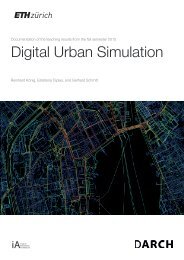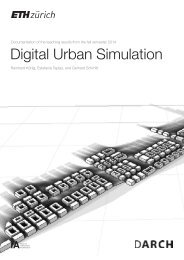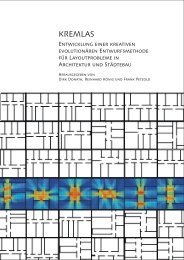New methods in urban analysis and simulation
Documentation of teaching results from the spring semester 2015 of the seminar Digital Urban Simulation at the Chair of Information Architecture, ETH Zurich
Documentation of teaching results from the spring semester 2015 of the seminar Digital Urban Simulation at the Chair of Information Architecture, ETH Zurich
Create successful ePaper yourself
Turn your PDF publications into a flip-book with our unique Google optimized e-Paper software.
1<br />
< <strong>analysis</strong> criteria ><br />
Isovist Area<br />
This Aspect shows, how large the area is that can be observed from a certa<strong>in</strong> po<strong>in</strong>t. It gives an idea of how<br />
public or <strong>in</strong>timate a space might feel.<br />
Red = A large area can be observed from this po<strong>in</strong>t. In reverse this po<strong>in</strong>t might feel very public <strong>and</strong> open.<br />
Blue = A small area can be observed from this po<strong>in</strong>t. In reverse this po<strong>in</strong>t might feel <strong>in</strong>timat <strong>and</strong> enclosed.<br />
Visual Integration<br />
The Integration value shows how much an area is visually central with<strong>in</strong> a context. It is possible that a space<br />
has a small isovist area value because it is heavily enclosed but at the same time has a relatively high visual<br />
<strong>in</strong>tegration value because a few steps away it is situated with<strong>in</strong> the visual center of an area.<br />
Red = Visually central.<br />
Blue = Visually peripeheral.<br />
Angular Mean Depth<br />
Depth describes how far away a po<strong>in</strong>t from all the other po<strong>in</strong>ts is. With the angular mean depth, the distance<br />
is measured <strong>in</strong> angular changes that represent a path. The more depth a space has, the more <strong>in</strong>convenient<br />
are the ways to the other spaces as there are a lot of angular changes with<strong>in</strong> the path.<br />
Red = Peripheral po<strong>in</strong>t with ways that <strong>in</strong>clude many angular changes until the other po<strong>in</strong>ts are reached.<br />
Blue = Central po<strong>in</strong>t with ways that <strong>in</strong>clude few angular changes until the other po<strong>in</strong>ts are reached.<br />
Color Code<br />
Red represents the highest values, blue represents the lowest values. The <strong>analysis</strong> data was scaled to the<br />
same color range to make a direct visual comparison possible. As a consequence of this procedure, the<br />
m<strong>in</strong>imum <strong>and</strong> maximum values may not be reached by some proposals.<br />
<strong>New</strong> Methods <strong>in</strong> Urban Analysis <strong>and</strong> Simulation I<br />
44








